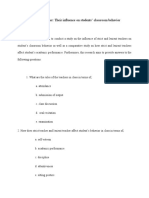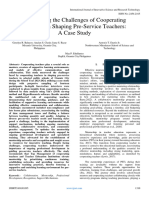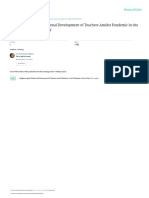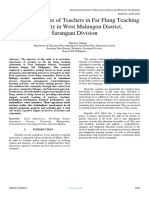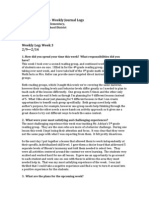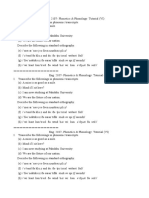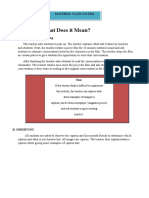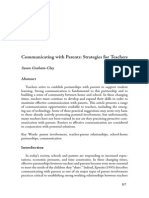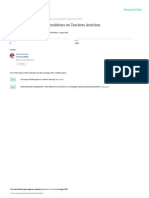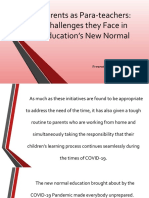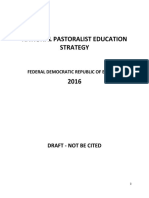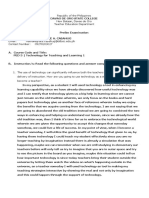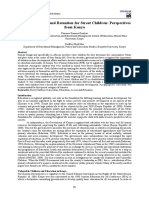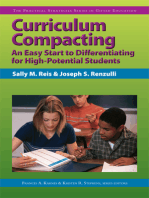A Sequential Explanatory Approach On Behavioral Flexibility and Commitment of Teachers in Talomo-A District, Davao City
A Sequential Explanatory Approach On Behavioral Flexibility and Commitment of Teachers in Talomo-A District, Davao City
Volume 9, Issue 9, September– 2024 International Journal of Innovative Science and Research Technology
ISSN No:-2456-2165 https://doi.org/10.38124/ijisrt/IJISRT24SEP1166
A Sequential Explanatory Approach on
Behavioral Flexibility and Commitment of
Teachers in Talomo-A District, Davao City
Mary Jean R. Concepcion
The Rizal Memorial Colleges, Inc.
Davao City, Philippines
Abstract:- This study examined how teaching resilience Studies show a link between teacher resilience and
affects teacher commitment. Explanatory sequential commitment. These studies solely examined how resilience
mixed approaches were used to collect data from 198 affects teacher commitment directly. Basım and Çetin (2011)
public elementary school teachers in Talomo-A District, found that increased resilience leads to increased employee
Davao City. Among quantitative responders, 17 were commitment to organizations. According to Polat and
selected for IDI and FGD. Teacher commitment was Iskender (2012), resilient teachers will absorb the
moderate, while behavioral flexibility was great. organization's laws and their school obligations and wish to
Behavioral flexibility in self-assurance, organization, and offer more to their organizations.
interpersonal competency strongly influenced teacher
commitment, according to regression analysis. Thematic According to Kiral and Kacar (2016), devoted
analysis of qualitative data showed that teachers had instructors understand school goals and values, struggle for
broad behavioral flexibility, moderate commitment, and the organization, and plan to stay. Additionally, Lin and Wang
that behavioral flexibility strongly influences (2012) found that deeply dedicated teachers work hard, are
commitment. The regression model shows that behavioral competent, and are more attached to the organization.
flexibility is one reason instructors' commitment is Moolenaar et al. (2012) found that continuous commitment
somewhat high. The data integration method connecting- helps employees stay in the organization because they have an
merging-confirmation explained the study's quantitative emotional connection.
outcomes using qualitative results. Thus, the study was
done to publish findings in respectable research journals. Research shows that weak teacher engagement at all
levels is a growing issue in educational institutions globally.
Keywords:- Educational Management, Behavioral As a fact, Namigadde (2011) reported that teachers'
Flexibility, Commitment, Sequential Explanatory Mixed- commitment was grossly inadequate, as shown by rampant
Method Approach, Davao City, Philippines. absenteeism, lateness, failure to assess students' work on time,
part-time teaching in more than two schools to top up their
I. INTRODUCTION salary, need, and satisfaction, and even teaching on Saturdays
and Sundays and at night, which resulted in student exam
The Problem and its Scope malpractice and low performance. Armstrong (2016) also
Lifelong behavioral flexibility improves emotional and noted that insufficient teacher engagement leads to a lack of
social well-being and helps teachers handle challenging self-improvement activities, which hinders school
educational tasks. It requires flexibility and adaptability, the collaboration. Poorly committed teachers had less job-
ability to ‘bounce back’ from adversity, and empathy for competency collaboration, according to Petty and Hill (2017).
others. It values relationship skills as much as self-awareness.
It requires seeing difficulties as challenges and valuing Baloran and Hernan (2020) also stated that poorly
preventive and proactivity. Thus, assessing instructors' committed teachers have plagued emergency remote
behavioral flexibility can help determine their commitment to education. The abrupt switch from physical classrooms to
teaching. online learning platforms had made teachers less committed to
teaching, the authors said. According to Ebuenga-Amora
According to Brouskeli et al. (2018), behavioral (2020), teachers become less committed to students' education
flexibility is the act of coping with disruptive, stressful, or and emotional, social, cognitive, physical, and spiritual well-
demanding life situations in a way that offers more protective being due to other personal struggles they face to equip
and coping abilities before the disruption. According to themselves with drastic curricular changes like adjusting their
Linnenluecke (2017), behavioral flexibility is the ability of teaching-learning activities to establish teacher presence and
employees to recover from setbacks and stay positive about adopting modular learning.
future events.
IJISRT24SEP1166 www.ijisrt.com 2222
Volume 9, Issue 9, September– 2024 International Journal of Innovative Science and Research Technology
ISSN No:-2456-2165 https://doi.org/10.38124/ijisrt/IJISRT24SEP1166
Most behavioral flexibility and teacher sentiment Pragmatism views truth as a matter of individual or
research were done abroad and employed quantitative or social relevance rather than an absolute concept, according to
qualitative methods. The researcher has not found any Basal et al. (2017). Pragmatically, the research findings are
quantitative and qualitative studies on these variables. Thus, acceptable rather than absolute (Tashakkori & Teddlie 2010).
the researcher felt compelled to fill the research gap by To answer this study's questions, the researcher will collect
performing a mixed methods study in Talomo-A District, data using quantitative and qualitative methodologies.
Davao City. The researcher employed a sequential
explanatory design to better explain teachers' commitment as According to Resilience Theory (Bobek, 2002), teachers
measured by behavioral flexibility, which is rare. This study must be resilient to handle the obstacles of teaching. He added
sought to expand Davao City's teacher commitment research. that resilient instructors can assess problems, find solutions,
This study is limited to Davao City, Philippines. The and act on them. He stressed that instructors can build
conclusions of this study may aid schools, especially resilience by building positive relationships with people who
instructors and administrators. understand teaching problems and can offer advice on how to
handle different scenarios.
Theoretical/Conceptual Framework
Pragmatists like the researcher consider individual As seen in Figure 1, the study has two variables.
realities as creations of various personal experiences and ideas Behavioral flexibility—the ability to recover, tolerate
rather than absolutes (Maddux & Donnett, 2015). Since facts hardship, and repair oneself—is the study's independent
and accuracy vary by person, place, and time, pragmatic variable. Self-assurance, belief in one's ability to achieve
exploration gives best results. Like Terrell (2012), the specific performance levels that influence life events; personal
researcher will use a pragmatic paradigm that combines data vision, reflecting commitment in the workplace influenced by
collection and analysis methods throughout the research family, spirituality, physical well-being, leisure, and work;
process (Creswell, 2013). adaptability, indicating openness to new ideas and concepts;
and organization, which involves effective planning to
maintain alignment with.
Fig 1 The Conceptual Framework of the Study
IJISRT24SEP1166 www.ijisrt.com 2223
Volume 9, Issue 9, September– 2024 International Journal of Innovative Science and Research Technology
ISSN No:-2456-2165 https://doi.org/10.38124/ijisrt/IJISRT24SEP1166
Purpose Statement understanding than a single data source (Creswell, 2013).
This sequential explanatory study examined how According to Creswell (2013), the researcher used the
behavioral flexibility affects teacher commitment in Talomo strengths of both quantitative survey data and qualitative
A District, Davao City, using customized survey insights from FGDs and IDIs to identify how the qualitative
questionnaires in the quantitative phase and in-depth findings expanded the quantitative ones.
interviews (IDI) and focus group discussions (FGD) in the
qualitative phase. The quantitative phase of the experiment Research Respondents
used customized survey questionnaires to obtain data from In the quantitative phase of the study, 198 public
public elementary school teachers on resilience and elementary school teachers from Talomo A District, Division
commitment. of Davao City, were selected using stratified random
sampling, focusing on permanent-regular teachers who
IDI and FGD collected teacher commitment opinions, voluntarily signed the informed consent form (ICF). The
feedback, and experiences. Combining quantitative and study's design did not consider the gender or socio-economic
qualitative data improves study methodologies and confirms status of the respondents. In the qualitative phase, the
results. The findings significantly imply that behavioral researcher purposively selected 10 public elementary school
flexibility affects teachers' commitment in Talomo A District, teachers for in-depth interviews (IDIs) and 7 secondary school
Davao City, public elementary schools. teachers for focus group discussions (FGDs), totaling 17
participants. Inclusion criteria required teachers to have at
Research Questions least three years of experience, ensuring a balanced
The research questions underlying the investigation in representation of genders. This approach aligns with
this study are as follows: recommendations for FGDs to maintain manageable group
sizes for effective discussion (Crouch and McKenzie, 2006).
What are the standpoints of the participants on the salient
points of the results on the extent of behavioral flexibility Purposive sampling was suitable for qualitative
of teachers in Talomo A District, Davao City? participant selection in this study because Daymon and
What are the standpoints of the participants on the salient Holloway (2011) define it as a method for selecting a sample
points of the results on the extent of commitment of based on their unique traits or traits that enable detailed
teachers in Talomo A District, Davao City? exploration and understanding of the study's constructs and
What are the standpoints of the participants on the salient research questions. Miles, et al. (2014) suggest purposive
points of the results on the influence of behavioral sampling for in-depth qualitative studies.
flexibility on commitment of the teachers in Talomo A
District, Davao City? Research Instrument
How do the qualitative results explain the quantitative This study used two sets of instruments: one for the
results of the study? quantitative phase and one for the qualitative phase. Both
were content validity assessed by experts and pilot tested for
Hypothesis reliability. The quantitative phase used two tailored survey
The following hypotheses was tested at 0.05 level of questionnaires. First tested behavioral flexibility by Russelle
significance: Consulting Inc. (2019) over eight categories with a Cronbach
coefficient of 0.90, showing excellent reliability. Items were
H01: Behavioral flexibility does not have significant contextualized and structured using a 5-point Likert scale. The
influence on commitment of teachers in Talomo A Commitment Questionnaire, derived from Thien et al. (2014),
District, Davao City. measured commitment across four areas with a Cronbach
coefficient of 0.89. The researcher used an interview guide
II. METHDOLOGY with open-ended questions to conduct semi-structured
interviews and focus group discussions with 17 public
Research Design elementary school teachers for the qualitative phase.
In this study, the researcher used an explanatory According to Bryman and Bell (2011), this flexible method
sequential research design to combine quantitative and allowed the investigation of new resilience and commitment
qualitative data (Creswell, 2013). This growing method themes, and three educational professionals verified the guide
simultaneously gathers, analyzes, and discusses both forms of and provided feedback for the final changes.
data, allowing qualitative findings to explain or improve
quantitative results (West, 2012). The quantitative phase Data Analysis
measured the relationship between behavioral flexibility and The researcher used different statistical tools to evaluate
teacher commitment using descriptive correlation (Schmitz, public elementary school teachers' data in Talomo-A District,
2012), while the qualitative phase explored secondary public Davao City, in the quantitative phase. The mean measured
school students' lived experiences in Talomo A District, teachers' behavioral flexibility and commitment, whereas
Davao City using phenomenology (Creswell, 2017). Pearson Product Moment Correlation examined their
Following survey questionnaires on learning styles and relationship. The impact of behavioral flexibility on teacher
classroom engagement, focus group discussions (FGDs) and commitment was examined using linear regression. In the
in-depth interviews (IDIs) provided a more dynamic qualitative phase, in-depth interviews (IDIs) and focus group
discussions (FGDs) were examined using thematic analysis to
IJISRT24SEP1166 www.ijisrt.com 2224
Volume 9, Issue 9, September– 2024 International Journal of Innovative Science and Research Technology
ISSN No:-2456-2165 https://doi.org/10.38124/ijisrt/IJISRT24SEP1166
uncover and record research question-related patterns or were integrated to complement and clarify conclusions, with
themes. qualitative insights verifying or opposing quantitative results.
This data gathering procedure involves scheduling interviews
To clarify survey results, the sequential-explanatory and FGDs at participants' convenience and recording with
mixed methods study confirmed quantitative data with consent. Six steps of thematic analysis led to a full
qualitative conclusions. Quantitative data gave factual interpretation, discussions, consequences, and
evidence, while qualitative data added depth. Both data sets recommendations.
Fig 2 The Conceptual Framework of the Study
IJISRT24SEP1166 www.ijisrt.com 2225
Volume 9, Issue 9, September– 2024 International Journal of Innovative Science and Research Technology
ISSN No:-2456-2165 https://doi.org/10.38124/ijisrt/IJISRT24SEP1166
III. RESULTS AND DISCUSSIONS achieved a mean rating of 4.23, characterized as very
extensive and consistently observed. This indicates that
A. Behavioral Flexibility of Teachers in Talomo-A District, educators have a robust confidence in their abilities, which
Davao City affects their capacity to manage challenges. This finding
Table 1 demonstrates that teachers' behavioral flexibility supports Doney's (2012) assertion that elevated resilience
was evaluated as extensive, with a category mean of 3.52, levels are essential for teachers to confidently navigate
interpreted as frequently observed. The average ratings for professional challenges. Furthermore, it aligns with the
specific items varied between 3.16 and 4.23. The statement findings of Holzberger et al. (2014), who contend that self-
"Being confident in my ability to face and overcome difficult assurance, self-esteem, and self-efficacy are essential
challenges" obtained a mean rating of 3.16, classified as components of teacher motivation, well-being, and personal
moderately extensive. In contrast, "Believing that I have the achievements.
knowledge, skills, and abilities to deal with almost anything"
Table 1 Behavioral Flexibility of Teachers in Terms of Self-assurance
Table 2 reveals that teachers’ behavioral flexibility extensive and oftentimes observed. This suggests that
regarding personal vision received an extensive category personal commitments in the workplace are influenced by
mean rating of 3.67, indicating that this aspect of their well- factors such as family, spirituality, physical well-being,
being is oftentimes observed. Mean ratings for specific items leisure, and work, which are sometimes recognized. This
ranged from 3.24 to 4.11. The item "Knowing what’s aligns with Fischer's (2014) assertion that personal vision is
important to me in my life" had a mean rating of 3.24, nurtured by support from others, fostering cohesion and trust.
described as moderately extensive and sometimes observed, Additionally, it supports Helms' (2012) view that a strong
while "Having a pretty good idea of what I want to personal vision allows individuals to envision the future and
accomplish in my work and life" scored 4.11, categorized as inspire others toward shared aspirations.
Table 2 Behavioral Flexibility of Teachers in Terms of Personal Vision
Teachers’ behavioral flexibility, in terms of adaptability, received a mean rating of 3.02, indicating a moderate extent
received a category mean of 3.26, classified as moderately of occurrence. In contrast, "Approaching new situations with
extensive, suggesting that this trait is occasionally observed an open mind" achieved a score of 3.46, reflecting an
among them. The average ratings for particular items varied extensive and frequent observation. This indicates that
between 3.02 and 3.46. The item "Willing and able to make respondents occasionally demonstrate receptiveness to novel
adjustments to my goals and plans when situations change" concepts, the capability to operate autonomously or in
IJISRT24SEP1166 www.ijisrt.com 2226
Volume 9, Issue 9, September– 2024 International Journal of Innovative Science and Research Technology
ISSN No:-2456-2165 https://doi.org/10.38124/ijisrt/IJISRT24SEP1166
collaboration as required, and the proficiency to handle adaptability are crucial qualities for teachers, as plans can
multiple projects under varying circumstances. This finding change quickly and unexpectedly.
supports Arendale's (2018) assertion that flexibility and
Table 3 Behavioral Flexibility of Teachers in Terms of Flexible and Adaptable
Teachers' behavioral flexibility regarding organization and occasional observation. The item "Finding a way to create
received a category mean of 3.23, classified as moderately systems or structures that provide useful control during major
extensive, suggesting that this trait is occasionally observed changes" received a score of 3.36, indicating a moderate
among teachers in Davao City. The mean ratings for specific extent of observation and occurrence. This indicates that
items varied between 3.08 and 3.36. The item "Trying to write although educators strive to structure their ideas and develop
out my thoughts when confused about what to do" received a effective systems, these practices are not uniformly
mean rating of 3.08, indicating a moderate level of frequency implemented.
Table 4 Behavioral Flexibility of Teachers in Terms of Organized
This suggests that the organizational skills of elementary extensive, indicating that this characteristic is frequently
public school teachers in their planning are occasionally observed. Mean ratings for particular items varied between
noted. This finding supports Leahy's (2012) assertion that 2.08 and 4.26. The item "Trying to identify the relationships
teaching is a profession characterized by stress and conflict, between the problem I am solving and other issues" received a
while teachers are nonetheless expected to maintain high score of 2.08, indicating it is less extensive and infrequently
levels of efficiency. This also corroborates Rodie's (2011) observed. Conversely, the item "Spending time defining the
assertion that educators must skillfully navigate diverse problem before making a decision" received a mean rating of
situations while preserving their effectiveness. 4.26, indicating it is categorized as very extensive and
consistently observed. This indicates that although teachers
In terms of problem-solving, teachers exhibited a are thorough in identifying problems, they may find it
behavioral flexibility mean score of 3.53, classified as challenging to relate these issues to wider contexts.
IJISRT24SEP1166 www.ijisrt.com 2227
Volume 9, Issue 9, September– 2024 International Journal of Innovative Science and Research Technology
ISSN No:-2456-2165 https://doi.org/10.38124/ijisrt/IJISRT24SEP1166
Table 5 Behavioral Flexibility of Teachers in Terms of Problem Solver
This shows that teachers can fix classroom issues by averaged 3.14–4.11. "Finding it easy to empathize with
seeking help or working alone. This supports Polat and others" scored 3.14, indicating moderate extent and occasional
Iskender (2018)'s claim that adaptation and problem-solving observation. "Being able to maintain effective relationships in
boost resilience. A teacher's efficacy depends on their stressful situations" earned a mean value of 4.11, indicating
capacity to succeed, handle stress, address school issues, be broad and frequent observation. This suggests that Governor
responsible and consistent, and self-develop. Generoso, Davao Oriental instructors value human relations
and social interactions for professional success. This supports
In interpersonal competence, instructors' behavioral Gemora (2014)'s claim that interpersonally skilled people can
flexibility obtained a category mean value of 3.66, suggesting form supporting networks during stressful occasions.
that this quality is often noticed. Specific item ratings
Table 6 Behavioral Flexibility of Teachers in Terms of Interpersonal Competence
Teacher behavioral flexibility in being socially with friends" got a mean grade of 4.42, indicating extensive
connected obtained an extensive category mean grade of 3.74, and constant observation. This suggests teachers feel linked to
indicating that this attribute is widely encountered. Specific their school community. These supports Spilt et al. (2011),
item ratings averaged 3.15 to 4.42. The item "Having a who argue that teachers need to connect with their students
diverse group of people whom I consider good friends" scored and that excellent teacher-student connections boost
3.15, indicating moderate extent and occasional observation. professional and personal self-esteem.
In contrast, "Participating in non-work-related group activities
IJISRT24SEP1166 www.ijisrt.com 2228
Volume 9, Issue 9, September– 2024 International Journal of Innovative Science and Research Technology
ISSN No:-2456-2165 https://doi.org/10.38124/ijisrt/IJISRT24SEP1166
Table 7 Behavioral Flexibility of Teachers in Terms of Socially Connected
Teachers' proactive behavioral flexibility obtained an biggest difference" got a mean value of 4.02—extensive and
extensive category mean grade of 3.55, indicating this quality regularly noted. This suggests that Talomo A District
is regularly encountered. Specific item ratings averaged 3.11– instructors often overcome difficulty and grow. According to
4.02. The item "Tending to focus my energy on how I can Luthans et al. (2011), individual resilience is the ability to
make the best of a situation" scored 3.11, indicating modest absorb strain and maintain or improve functioning during
extent and occasional observation. However, "Believing that obstacles.
my own decisions and actions during a change will make the
Table 8 Behavioral Flexibility of Teachers in Terms of Proactive
Table 9 shows that teachers' behavioral flexibility is shows that teachers regularly overcome obstacles. This
regularly seen, with a mean score of 3.52. The domain supports Luthans et al. (2011), who believe resilience
"socially connected" had the greatest mean score at 3.74, improves performance during major changes, and Brouskeli et
indicating extensive, while "organized" had the lowest at 3.23, al. (2018), who believe resilience increases protective and
indicating moderately extensive and sometimes noticed. This coping skills during stressful experiences.
Table 9 Extent of Behavioral Flexibility of Teachers in Talomo-A District, Davao City
IJISRT24SEP1166 www.ijisrt.com 2229
Volume 9, Issue 9, September– 2024 International Journal of Innovative Science and Research Technology
ISSN No:-2456-2165 https://doi.org/10.38124/ijisrt/IJISRT24SEP1166
Qualitative Result. “In my own perspective, school head and colleagues’
Table 10 presents the participants' perspectives on the support and harmonious yet firm working environment are
quantitative findings regarding the extensive ratings of factors that strengthen my resiliency because these make me
teachers' behavioral flexibility in Talomo A District, Davao feel that I am on the right track and my effort, time and work
City. Participants indicated that they frequently demonstrate are essential and beneficial to our school and colleagues
the ability to cope with teaching challenges, often engaging in especially to our client- our school children.” (IDI # T_004)
various activities and collaborating with colleagues to address
work-related issues. Below are some of the shared narratives “The factors that strengthen my resilience that
from the participants: contributed to my commitment as a teacher are the following,
number one leadership of my school head, next the healthy
“The collaboration and understanding among environment in school with my colleagues and parents as well
colleagues help me become resilient in facing challenges.” and the synergy I had experienced now in my station.” (PIQ,
(IDI # T_003) FGD # T_002)
“Engaging in spiritual activities is the factor that retains
my resilience.” (IDI # T_003)
Table 10 Standpoints of the Participants on the Quantitative Results Regarding the Extent of Behavioral
Flexibility of Teachers in Talomo a District, Davao City
The conclusion suggests that reciprocity in the teacher- B. Commitment of the Teachers in Talomo-A District, Davao
student interaction is increasingly linked to teacher resilience. City
This supports Kyriacou (2011)'s claim that resilience Table 11 shows that Talomo A District, Davao City,
motivates teachers to enhance mental health, classroom teachers' school dedication is regularly seen with a category
safety, and resilience in their pupils. The study also supports mean of 3.56. Different things average 3.12 to 4.13 ratings. In
Spilt et al. (2011)'s findings that teachers need to feel particular, "Finding it easy to agree with the school's policies
connected to their pupils and that teacher-student connections on important matters" had a mean value of 3.12, suggesting
might affect teachers' professional and personal self-esteem. somewhat substantial use. Conversely, "Feeling obliged to
mediate among the rival groups of students" scored 4.13,
indicating instructor commitment. This shows that teachers
generally support the school's goals and beliefs, resulting in
active participation in school events and a willingness to go
above and beyond.
Table 11 Extent of Commitment of Teachers in Terms of Commitment to School
IJISRT24SEP1166 www.ijisrt.com 2230
Volume 9, Issue 9, September– 2024 International Journal of Innovative Science and Research Technology
ISSN No:-2456-2165 https://doi.org/10.38124/ijisrt/IJISRT24SEP1166
The fairly extended category mean of 3.09 in Table 12 this commitment is generally met. While teachers may be
indicates that teachers' dedication to pupils is sometimes driven to help students through personal crises and develop
shown. Item evaluations average 2.55 to 3.45. Note that them, they may not always be committed to student
"Feeling obliged to mediate among rival student groups" had participation. According to Adunola (2011), devoted teachers
a mean value of 2.55, indicating an uncommon and limited use varied instructional tactics to meet their students'
occurrence. However, "Ensuring good social relations among multifaceted requirements.
my students as my responsibility" scored 3.45, showing that
Table 12 Extent of Commitment of Teachers in Terms of Commitment to Student
Table 13 shows that the mean score for teachers' indicates that teachers typically exhibit a high level of
commitment to teaching is 3.62, categorized as extensive, commitment to teaching, thereby increasing their involvement
suggesting it is frequently demonstrated. The average ratings in the teaching-learning process. This finding is consistent
for different items vary between 3.35 and 3.89. The item with Moolenaar et al. (2012), who observed that individuals
"Perceiving myself as more committed as a teacher" received with high work commitment exhibit more positive emotions
a mean rating of 3.35, indicating that this perception is regarding their occupation, as evidenced by their readiness to
sometimes evident. Conversely, the item "Enjoying teaching" invest effort, enthusiasm, and additional time for their
received a score of 3.89, suggesting that this commitment is students.
frequently evident among teachers in Davao City. This
Table 13 Extent of Commitment of Teachers in Terms Commitment to Teaching
Table 14 indicates that teachers' commitment to their achieved a score of 3.45, suggesting that this commitment is
profession has a category mean of 3.19, suggesting that it is frequently observed. This indicates that educators are
occasionally demonstrated. The average ratings for different sometimes driven to improve their profession. This finding is
items vary between 2.85 and 3.45. The item "Feeling that I am consistent with Anttila (2014), who highlighted that
proud that I ever entered the teaching profession" received a commitment to the teaching profession entails an emotional
mean rating of 2.85, categorized as moderately extensive. In connection associated with personal satisfaction and
contrast, "Reflecting that if I could do it all over again, I identification as a teacher, which is essential for cultivating
would still choose to work in the teaching profession" the skills and relationships required for a successful career.
Table 14 Extent of Commitment of Teachers in in Terms of Commitment to Profession
IJISRT24SEP1166 www.ijisrt.com 2231
Volume 9, Issue 9, September– 2024 International Journal of Innovative Science and Research Technology
ISSN No:-2456-2165 https://doi.org/10.38124/ijisrt/IJISRT24SEP1166
Table 15 illustrates the overall commitment of teachers This indicates that teachers sometimes exhibit a strong
in Talomo A District, Davao City, with a mean score of 3.37, commitment to the organization’s goals and values. The
suggesting that it is occasionally exhibited. Among the findings are consistent with Richards (2014), who observed
various dimensions of commitment, Commitment to Teaching that commitment encompasses employees' dedication to
received the highest score of 3.62, characterized as extensive achieving organizational objectives and engaging proactively.
and frequently observed, whereas Commitment to Students This aligns with the perspectives of Kiral and Kacar (2016)
obtained the lowest score of 3.09, classified as moderately regarding teacher commitment, which involves the acceptance
extensive and occasionally observed. and internalization of school objectives, prompting teachers to
engage actively and remain within the organization while
considering the costs related to turnover.
Table 15 The Summary on the Extent of Commitment of Teachers in Talomo A District, Davao City
Qualitative Results. Table 16 presents participants' views educator. My patience allows me to work effectively with even
on the moderately extensive rating of teacher commitment in the most challenging students.” (IDI # T_008)
Talomo A District, Davao City. This rating was derived from
responses in Individual Deep Interviews (IDI) and Focus “I rendered teaching services beyond office hours when
Group Discussions (FGD). Five key themes emerged, necessary.” (IDI # T_004)
reflecting core ideas about teacher commitment: development
of students’ self-esteem, efficiency in work and “I conduct extensive and constant follow up to my
responsibilities, creation of a conducive learning environment, students academic status during this new normal set up of
focus on learning goals, and maintaining a positive attitude. education. I conduct frequent communication to parents to
As shared by the participants: ensure the submission of students’ modules.” (IDI # T_009)
“I work beyond office hours and bring my work at home. “I set time and goals in completing school tasks.
I used personal money to defray expenses for classroom However, I sometimes extend my work at home when
improvement. Also, I enrolled in graduate school for necessity calls. I always consider my students as my top
professional development.” (IDI # T_001) priority when I am in school rather than paper works.” (FGD
# T_006)
“I set time and goals in completing school tasks.
However, I sometimes extend my work at home when The results suggest that teacher commitment motivates
necessity calls. I always consider my students as my top educators to fully embrace school goals and strive to achieve
priority when I am in school rather than paper works.” (IDI # them. This aligns with Brown's (2011) view that highly
T_006) committed teachers actively support school objectives.
Additionally, Richards (2014) states that commitment
“I give individualized attention to my student. I am adept involves dedication to fulfilling an organization's purposes.
at identifying and maximizing the strengths of each student Ideally, a committed employee is self-motivated and
and learning their weaknesses so that I can be a better help contributes valuable innovation and efficiency without
each individual child excel to his or her potential and I am needing supervision.
also patient, which is a trait that is a must-have for any
Table 16 Standpoints of the Participants on the Quantitative Results Regarding the Extent of
Commitment of Teachers in Talomo A District, Davao City
IJISRT24SEP1166 www.ijisrt.com 2232
Volume 9, Issue 9, September– 2024 International Journal of Innovative Science and Research Technology
ISSN No:-2456-2165 https://doi.org/10.38124/ijisrt/IJISRT24SEP1166
Participants in this study reported their punctuality and “These experiences shape my beliefs by embracing the
readiness to work beyond standard office hours. This finding reality and indulging the new normal, appealing the positivity
supports Pantic's (2011) assertion that teachers' commitment and strengthening the commitment as teacher and
to their profession motivates innovation and adaptation, empowering as good leader and best follower. To be more
promoting critical, evidence-based attitudes that address effective and produce quality education, we must be
student outcomes. Steinert et al. (2015) highlight that competent enough and committed to our profession.” (FGD #
commitment represents the manner in which teachers T_004)
incorporate their responsibilities, knowledge, and skills within
a collegial context, conforming to professional standards that This finding supports Tanang and Abu's (2014)
include understanding, values, and insights pertinent to conclusion that teachers who participate in professional
teaching. development are more likely to adopt new instructional
methods and integrate technology compared to those who do
The high levels of commitment among teachers arise not. Additionally, it aligns with Jones and Dexter's (2016)
from their efforts to perform effectively, as they remain perspective that effective professional development should
informed about new teaching trends to enhance student connect learning to student achievement, offer hands-on
success. With conviction, the participants narrated the experiences, challenge teachers' beliefs and practices,
following: facilitate collaboration, and include mentoring and coaching,
while being timely and relevant.
“During pandemic, attending those numerous webinars
and trainings help me become more effective in my class. I C. Relationship between Relationship between Behavioral
used messenger, Facebook, and other means to still continue Flexibility and Commitment of Teachers in Talomo A
teaching that’s why my pupils are already readers.” (IDI # District, Davao City
T_001) The results of the analysis on the relationship between
behavioral flexibility and commitment of teachers in Talomo
“I keep on working on works that is doable at home. And A District, Davao City are presented. Bivariate correlation
I keep my self updated with the new technology in teachings.” analysis using Pearson Product Moment Correlation was
(IDI # T_002) utilized to determine the relationship between the variables
mentioned. Table 17 shows the relationships between
“These experience makes me realize and awaken me that behavioral flexibility and commitment of the teachers. It
I must be thankful that I am teacher my responsibility greatly shows that teaching resilience has a significant positive
contribute to the society in shaping the backbone of our relationship with the commitment of the teachers with a p-
community.” (FGD # T_001) value of .000 that is less than .05 level of significance (two-
tailed) (r = .882, p < 0.05). It means that as the extent of the
behavioral flexibility changes, commitment of teachers also
significantly changes.
Table 17 Relationship between Behavioral Flexibility and Commitment of Teachers in Talomo A District, Davao City
The finding is in consonance with the view of Polat and job withdrawal and absenteeism decrease. The result is also in
Iskender (2012) that teachers with higher levels of resilience agreement with Paul et al. (2016) that resilience predicts
will internalize the rules of the organization and their commitment suggests that measures of resilience could be
responsibilities within the school, and will want to contribute incorporated into recruitment and selection procedures so as
to their organizations more than other members of it. As to get resilient individuals on board.
teacher commitment increases, job performance increases, and
IJISRT24SEP1166 www.ijisrt.com 2233
Volume 9, Issue 9, September– 2024 International Journal of Innovative Science and Research Technology
ISSN No:-2456-2165 https://doi.org/10.38124/ijisrt/IJISRT24SEP1166
D. Influence of Teaching Behavioral Flexibility on the The analysis indicates that self-assurance, organization,
Commitment of the Teachers and interpersonal competence significantly affect teacher
The impact of behavioral flexibility on teacher commitment. Each unit increase in these domains is
commitment was examined through multiple linear regression associated with an increase in the odds of commitment by
analysis. Table 16 demonstrates the model's significance, 0.648, 0.240, and 0.214, respectively. Thus, the null
evidenced by an F-value of 343.711 and a p-value less than hypothesis, which posits that none of the domains of
0.05, indicating that behavioral flexibility serves as a predictor behavioral flexibility significantly affect teacher commitment,
of teacher commitment. The adjusted R² value of 0.630 can be rejected.
indicates that behavioral flexibility explains 63% of the
variability in teacher commitment, with the remaining 37%
attributable to other factors not considered in the study.
Table 18 Influence of Resilience on the Commitment of Teachers in Talomo A, Davao City
This supports Bobek (2002)'s Resilience Theory that “As committed teacher, my experienced involving
instructors must be resilient due to the challenges of teaching. professional development resilience and leadership self-
Teachers with resilience can identify problems, choose coping efficacy of my school head has a big help as pillar to grow me
strategies, and implement them. He noted that teachers might professionally, emotionally, mentally and spiritually. I want to
build resilience by forming productive relationships with explore or know more or more in holistic manner.” (IDI #
people who understand teaching challenges and can offer T_008)
advice on how to handle diverse scenarios.
“The engagement and collaboration of everyone
Qualitative Result. Given the standpoints of the especially with the people around makes a happy feeling and
participants from the in-depth interview and focus group inspired teacher to pursue teaching. Being more dedicated to
discussion, the participants confirmed the signiifcance on the face life’s challenges.” (IDI # T_010)
influence of behavioral flexibility on the commitment of
teachers in Talomo A in Davao City. The following are the “I think teachers must evaluate themselves from time to
shared views of the participants: time this is the check and balance of our self regarding on our
attitude because attitude is the key factor to have a smooth
“Teachers play vital role in the community. So we relationship with the coworker.” (FGD # T_001)
should always keep our integrity in highest standards because
we play significant role in values formation of the students.” The result shows that teachers are crucial to student
(IDI # T_002) learning. Teacher resilience is built by managing job demands
and time. This supports Rodie (2011)'s notion that teaching is
a profession where teachers must handle various situations
and operate efficiently.
IJISRT24SEP1166 www.ijisrt.com 2234
Volume 9, Issue 9, September– 2024 International Journal of Innovative Science and Research Technology
ISSN No:-2456-2165 https://doi.org/10.38124/ijisrt/IJISRT24SEP1166
Table 19 Standpoints of the Participants on the Quantitative Results Regarding the Influence of Behavioral Flexibility on
Commitment of Teachers in Talomo A District, Davao City
Adding more, the finding agrees with the idea of Kelly display of key quantitative and qualitative results, including
(2020) are expected to fill many different roles, which is why aspects such as points of comparison, quantitative findings,
teaching can be a challenging profession, hence, the key to qualitative findings, and the nature of integration. The
success in the field is a teacher's ability to organize herself, qualitative findings column outlines responses that either
her classroom, and her learners. confirm or disconfirm the quantitative results. The nature of
data integration column indicates the type of mixing used,
E. Data Integration on the Salient Quantitative and highlighting how qualitative findings provide explanations for
Qualitative Findings the quantitative results.
The fourth research question examines the integration of
quantitative and qualitative findings. Table 20 presents a joint
Table 20 Joint Display of the Salient Qualitative and Quantitative Findings
IJISRT24SEP1166 www.ijisrt.com 2235
Volume 9, Issue 9, September– 2024 International Journal of Innovative Science and Research Technology
ISSN No:-2456-2165 https://doi.org/10.38124/ijisrt/IJISRT24SEP1166
Table 20 shows self-confidence behavioral flexibility, account for 63% of commitment variability. The qualitative
with "Being confident in my ability to face and overcome findings supported the quantitative data, demonstrating a
difficult challenges" scoring 3.16. This matches qualitative shared understanding of district teacher commitment
findings in Table 10 showing a "increase in self-efficacy" determinants.
about resilience. The item "Finding that I am able to meet
both my needs and the needs of others in a changing B. Conclusions
environment" had a high grade of 3.43, confirming qualitative This study suggests numerous conclusions. Talomo A
findings that stressed "adapting to new environments." This District, Davao City, teachers showed great behavioral
shows that teachers' openness to novel settings improves flexibility in self-confidence, personal vision, adaptability,
organizational responsibility. Collie and Martin (2016) organization, problem-solving, interpersonal competence,
believe that teachers must be cognitive, behavioral, and social connectedness, and proactivity. Quantitative and
emotional adaptable when teaching novel subjects, requiring qualitative findings support the hypothesis that instructors
regulated ideas, behaviors, and emotions. often exhibit behavioral flexibility. The district's instructors
were somewhat committed to school, students, teaching, and
In organizational behavioral flexibility, "Finding a way profession. This suggests teachers' devotion is occasionally
to create systems or structures that provide control during visible, with qualitative study supporting the quantitative
major changes" earned a relatively comprehensive mean findings.
rating of 3.36, agreeing with qualitative insights on proactive
problem-solving. Leisure activities strengthen resilience, as The study found a strong positive correlation between
shown by the item "Participating in non-work-related group behavioral flexibility and instructor commitment. Self-
activities"'s high mean rating of 4.42. These studies show how confidence, organization, and interpersonal ability greatly
personal and professional goals and social activities help affected teacher commitment. The quantitative results and
teachers overcome hurdles. Fischer (2014) says shared qualitative data showed a cohesive understanding of how
personal visions build trust and coherence, whereas Helms these aspects are related. Comparable quantitative and
(2012) says powerful personal visions motivate others. qualitative data supported the study's conclusions.
Quantitative data also shows teachers' devotion. C. Recommendations
"Ensuring all students succeed" was moderately extensive Based on the findings, the researcher suggests that since
with a mean of 3.26, consistent with qualitative responses elementary public school instructors in Talomo A District,
highlighting "learning goals." Participants were also positive Davao City exhibit moderate commitment, the Department of
about "Contemplating a continued choice of teaching over Education should consider rewarding outstanding performers.
other professions" (mean 3.26). Teachers' role reflections Policymakers are encouraged to sustain teacher development
boost their professional involvement. Doney (2012) says programs, as these initiatives can enhance instructors'
resilient teachers can handle problems. These qualitative commitment to teaching despite challenges. Such programs
findings are supported by the significant effect of behavioral facilitate the sharing of ideas and foster interaction among co-
flexibility on teacher commitment (p-value = 0.000), teachers, helping educators to improve their skills and
demonstrating that resilience increases commitment and strategies, which in turn motivates them to engage in school
cooperation increases behavioral flexibility. According to activities. Thus, national, division, and local educational
Polat and Iskender (2012), resilience strengthens authorities should implement professional development
organizations. initiatives to bolster teacher dedication.
IV. CONCLUSIONS AND RECOMMENDATIONS Additionally, ongoing professional development is
essential for teachers, as it not only broadens their knowledge
A. Summary of Findings but also reinforces their strengths. Understanding how to
This mixed-methods, sequential-explanatory study enhance professional development can benefit both students
examined how teaching resilience affects teacher commitment and educators. Finally, given that behavioral flexibility
in Talomo A District, Davao City. The quantitative phase accounts for only 63.00% of the overall variability in teacher
examined how resilience affects commitment in public commitment, further research is needed to explore other
elementary school teachers using customized survey factors influencing teacher commitment.
questionnaires. A preliminary test verified the survey
instrument's reliability. Teachers' behavioral flexibility
averaged 3.52, showing broad flexibility in self-confidence
and interpersonal skills. Qualitative data from theme analysis
confirmed the quantitative results.
The mean teacher commitment was 3.37, moderately
extensive, with particular scores for school (3.56), students
(3.09), teaching (3.62), and profession (3.19). A substantial
positive correlation exists between behavioral flexibility and
teacher commitment, with a p-value of.000 and a r² value of
0.630. Self-confidence, organization, and interpersonal skill
IJISRT24SEP1166 www.ijisrt.com 2236
Volume 9, Issue 9, September– 2024 International Journal of Innovative Science and Research Technology
ISSN No:-2456-2165 https://doi.org/10.38124/ijisrt/IJISRT24SEP1166
REFERENCES [12]. Hodgkinson, M. (2012). A shared strategic vision:
Dream or reality? The Learning Organization, 9 (2),
[1]. Achurra, C., & Villardón, L. (2012). The relationship 89-95
between teacher self-efficacy and their teaching [13]. Johnson, S. (2018). The development and use of
practices. https://pdfs.semanticscholar.org/b759/ interpersonal competencies by evaluators.
5b26ed1fea1468c83bf315426d600b42b708.pdf. https://conservancy.umn.edu/bitstream/handle/11299/
[2]. Al-Alwan, A. F., & Mahasneh, M. (2014). Teachers’ 194558/Rassel_umn_0130E_18978.pdf?sequence=1
self-efficacy as determinant of students’ attitudes [14]. Kiral, E., & Kacar, O. (2016). The relationship
toward school: A study at the school level. Review of between teachers’ school commitment and school
European Studies, 6(1), 171-186. culture. International Education Studies, 9(12), 90-
https://www.semanticscholar.org/paper/Teachers'- 108. http://doi:10.5539/ies.v9n12p90
Self-efficacy-as-Determinant-of-Students'-Al-alwan- [15]. Leahy, T. (2012). How teachers develop and sustain
Mahasneh/c7e57fc319394723a831a0b8c47f01dc311c resilience in their
d745 [16]. Lee, K. (2013). Developmental change in executive
[3]. Awang, Z., Ahmad, J. H., & Zin, N. M. (2010). functioning. https://onlinelibrary.wiky.com
Modelling job satisfaction and work commitment [17]. Lyons, S. T., Schweitzer, L., & Ng, E. S. W. (2015).
among lecturers: A case of UiTM Kelantan. Journal of Resilience in the modern career. Career Development
Statistical Modeling and Analytics, 1(2), 45-59. International, 20(4), 363–383.
https://www.academia.edu/1585844/Modelling_Job_S [18]. McShane, S., & Von Glinow, M. (2012).
atisfaction_And_Work_Commitment_Among_Lectur Organizational behavior: Emerging knowledge.
ers_A_Case_Of_UiTM_Kelantan Global reality. (6th ed., p. 112). New York, NY:
[4]. Begley, P. (2010). Leading with moral purpose: The McGraw- Hill/Irwin.
place of ethics. The principles of Educational [19]. Moolenaar, N. M., Daly, A. J., & Sleegers, P. J.
Leadership and Management, 2, 31-54. (2010). Occupying the principal position:
https://www.slideshare.net/adeleepenner/the-place-of- Examining relationships between transformational
ethics leadership, social network position, and schools’
[5]. Blatt, R. (2011). Resilience in entrepreneurial teams: innovative climate. Educational administration
Developing the capacity to pull through. Frontier of quarterly, 46(5), 623-670. http://DOI: 10.1177/
Entrepreneurship Research, 29(11), 1-12. 0013161X10378689
[6]. Boey, E. K. (2010). Teacher empowerment in [20]. Myers, J. L., & Well, A. D., (2013). Research Design
secondary schools: A case study in Malaysia. Herbert and Statistical Analysis. 3rd Edition ed. New York:
UtzVerlag GmbH, Munchen. Germany Taylor and Francis.
[7]. Boniwell, I. & Ryan, L. (2012). Personal well-being [21]. Narinasamy, I. & Logeswaran, A. (2015). Teacher as
lessons for secondary schools: Positive psychology in moral model – Are we caring enough? World Journal
action for 11 to 14 year-olds. Oxford: McGraw-Hill. of Education Vol. 5, No. 6; 2015.
[8]. Britt, T., Shen, W., Sinclair, R., Grossman, M., & https://files.eric.ed.gov/fulltext/EJ1158411.pdf
Klieger, D. (2016). How much do we really know [22]. Nie, Y., Tan, G. H., Liau, A. K., Lau, S., & Chua, B.
about employee resilience? Industrial and L. (2013). The roles of teacher efficacy in
Organizational Psychology, 9(2), 378–404. instructional innovation: Its predictive relations to
https://www.researchgate.net/publication/304809668_ constructivist and didactic instruction. Educational
How_Much_Do_We_Really_Know_About_Employe Research for Policy and Practice, 12(1), 67–77.
e_Resilience http://www.springer.com/education+%26+language/jo
[9]. Brouskeli, V., Kaltsi, V., & Loumakou, M. (2018). urnal/10671
Resilience and occupational well-being of secondary [23]. Petty, G. C., & Hill, R. B. (2017). Work ethic
education teachers in Greece. http://www.iier.org. characteristics: Perceived work ethics of supervisors
au/iier28/brouskeli.pdf and workers. Journal of STEM Teacher Education,
[10]. Gemora, R. (2014). Influence of interpersonal 42(2), 2. https://ir.library.illinoisstate.edu/cgi/
relationship on the administrative and teaching viewcontent.cgi?article=1218&context= jste
performance among faculty administrators. [24]. Polat, D. D., & Iskender, M. (2018). Exploring
http://apjeas.apjmr.com/wp-content/uploads/2014/ teachers’ resilience in relation to job satisfaction,
07/APJEAS-2014-1-045.pdf burnout, organizational commitment and perception of
[11]. George, K. (2014). Resilience in academic stress: organizational climate. International Journal of
Exploring the role of cognition in how students adjust Psychology and Educational Studies, 5(3), 1-13.
to life at the University of York.
http://etheses.whiterose.ac.uk/7856/1/Final%20versio
n%20-%20Resilience%20in%20Academic% 20Stress
%20%28PhD%20Thesis%20of%20Karisha%20K.%2
0George%29.pdf
IJISRT24SEP1166 www.ijisrt.com 2237
You might also like
- Effect of Lesson Planning On Teacher PerformanceNo ratings yetEffect of Lesson Planning On Teacher Performance43 pages
- Lived Experiences of Bago City College Instructors On The Utilization of TechnologyNo ratings yetLived Experiences of Bago City College Instructors On The Utilization of Technology79 pages
- Uncovering The Challenges of Cooperating Teachers in Shaping Pre-Service Teachers: A Case StudyNo ratings yetUncovering The Challenges of Cooperating Teachers in Shaping Pre-Service Teachers: A Case Study17 pages
- CMC- GSE-2024 IMRAD Submission-AMAHIDO, GERALDINENo ratings yetCMC- GSE-2024 IMRAD Submission-AMAHIDO, GERALDINE42 pages
- The Mediating Effect of Institutional Incentive System On Self-Efficacy and Teachers' Commitment in Talomo-A District, Davao CityNo ratings yetThe Mediating Effect of Institutional Incentive System On Self-Efficacy and Teachers' Commitment in Talomo-A District, Davao City12 pages
- Exploring Teachers' Current Working Condition On The Face-to-Face Classes: Voices of Public Elementary School TeachersNo ratings yetExploring Teachers' Current Working Condition On The Face-to-Face Classes: Voices of Public Elementary School Teachers10 pages
- Supervisory Effectiveness and Commitment of The Teachers As Mediated by Symbolic Leadership Orientation of School HeadNo ratings yetSupervisory Effectiveness and Commitment of The Teachers As Mediated by Symbolic Leadership Orientation of School Head13 pages
- Neuropsychological Cognition and Attitude Towards Mathematics As Predictors of Resilience Among Mathematics Pre-Service TeachersNo ratings yetNeuropsychological Cognition and Attitude Towards Mathematics As Predictors of Resilience Among Mathematics Pre-Service Teachers10 pages
- Compelling Educators' Needs: Graduate Studies PursuitsNo ratings yetCompelling Educators' Needs: Graduate Studies Pursuits10 pages
- Philippine Professional Standard For Teachers Based Competencies, Behavioral Skills and Their Performance100% (1)Philippine Professional Standard For Teachers Based Competencies, Behavioral Skills and Their Performance4 pages
- Moderating Effect of Accessary Environment On Teachers' Administrative Proficiency and Instructional Experiences in Talomo District, Davao CityNo ratings yetModerating Effect of Accessary Environment On Teachers' Administrative Proficiency and Instructional Experiences in Talomo District, Davao City12 pages
- Sustaining Perseverance and Commitment To Teach: Stories From Long-Serving Primary School TeachersNo ratings yetSustaining Perseverance and Commitment To Teach: Stories From Long-Serving Primary School Teachers12 pages
- Self-Efficacy, Working Conditions, School-Based Management Practices and Performance of TeachersNo ratings yetSelf-Efficacy, Working Conditions, School-Based Management Practices and Performance of Teachers19 pages
- DLP Study_Exploring students’ experiences in the dynamic learning program model_V2No ratings yetDLP Study_Exploring students’ experiences in the dynamic learning program model_V227 pages
- Understanding Teachers’ Self Efficacy on Blended Learning Instruction: The Challenges of Elementary Teachers in FocusNo ratings yetUnderstanding Teachers’ Self Efficacy on Blended Learning Instruction: The Challenges of Elementary Teachers in Focus6 pages
- Sufficiency of Flexible Learning Experience During The COVID-19 Pandemic Among Hospitality Management StudentsNo ratings yetSufficiency of Flexible Learning Experience During The COVID-19 Pandemic Among Hospitality Management Students7 pages
- Analysing Education Research LiteratureNo ratings yetAnalysing Education Research Literature11 pages
- Manapat Teacher Well Being On Professional DevelopmentNo ratings yetManapat Teacher Well Being On Professional Development17 pages
- Research Trends of Affective Commitment AmongTeacher A Bibliometric AnalysisNo ratings yetResearch Trends of Affective Commitment AmongTeacher A Bibliometric Analysis7 pages
- Out of The Classroom Context: Narratives of Licensed Teachers Assigned To School OfficesNo ratings yetOut of The Classroom Context: Narratives of Licensed Teachers Assigned To School Offices3 pages
- ActionresearchVIOLANTE MENTOR November62023No ratings yetActionresearchVIOLANTE MENTOR November6202315 pages
- Group 1 (BSED ENGLISH 2-B) Term Paper.docxNo ratings yetGroup 1 (BSED ENGLISH 2-B) Term Paper.docx22 pages
- Metacognitive Awareness and Work Task Motivation as Predictors of Teaching Competence among Public Elementary School Teachers: A Convergent DesignNo ratings yetMetacognitive Awareness and Work Task Motivation as Predictors of Teaching Competence among Public Elementary School Teachers: A Convergent Design50 pages
- The Impact of Frustration Tolerance On Academic Resilience Among Criminology StudentsNo ratings yetThe Impact of Frustration Tolerance On Academic Resilience Among Criminology Students23 pages
- Faculty Politics and Its Consequences: The Case of Punjab UniversityNo ratings yetFaculty Politics and Its Consequences: The Case of Punjab University49 pages
- The State of Teacher Empowerment in Schools: A Review of Retention Challenge and StrategiesNo ratings yetThe State of Teacher Empowerment in Schools: A Review of Retention Challenge and Strategies3 pages
- Darling-Hammond, L. and Richardson, N. (2009) - Teacher Learning.No ratings yetDarling-Hammond, L. and Richardson, N. (2009) - Teacher Learning.10 pages
- Heightening The Professional Development of Teachers Amidst Pandemic in The Philippines: A Case StudyNo ratings yetHeightening The Professional Development of Teachers Amidst Pandemic in The Philippines: A Case Study12 pages
- Lived Experiences of Teachers in Far Flung Teaching Community in West Malungon District, Sarangani DivisionNo ratings yetLived Experiences of Teachers in Far Flung Teaching Community in West Malungon District, Sarangani Division9 pages
- Working To Get There Student and Teacher Relationship Towards A Meaningful Teaching and Learning ExperiencesNo ratings yetWorking To Get There Student and Teacher Relationship Towards A Meaningful Teaching and Learning Experiences10 pages
- Weekly Student Teaching Reflective Journal100% (12)Weekly Student Teaching Reflective Journal5 pages
- Concept Paper Constructivist Learning Environment Management Skills and Resilience As Predicted by Work Values of Mathematics TeachersNo ratings yetConcept Paper Constructivist Learning Environment Management Skills and Resilience As Predicted by Work Values of Mathematics Teachers15 pages
- Nik Peachey - Digital Tools For Teachers PDFNo ratings yetNik Peachey - Digital Tools For Teachers PDF94 pages
- Amidst The New Normal: Teachers' Knowledge, Skills, and Attitude Towards The Implementation of Flexible Teaching and LearningNo ratings yetAmidst The New Normal: Teachers' Knowledge, Skills, and Attitude Towards The Implementation of Flexible Teaching and Learning10 pages
- BAHAN AJAR SMA KELAS XII Revisiii CooyyNo ratings yetBAHAN AJAR SMA KELAS XII Revisiii Cooyy70 pages
- The Impact of Working Conditions On Teachers AttritionNo ratings yetThe Impact of Working Conditions On Teachers Attrition21 pages
- Language Teachers' Beliefs and Practices Regarding The Appropriateness of Communicative Methodology: A Case Study From ThailandNo ratings yetLanguage Teachers' Beliefs and Practices Regarding The Appropriateness of Communicative Methodology: A Case Study From Thailand33 pages
- Ed 4 Module 7 Components of Special and Inclusive Education 2No ratings yetEd 4 Module 7 Components of Special and Inclusive Education 245 pages
- Teaching English in A Technological Institute With Problems and SolutionsNo ratings yetTeaching English in A Technological Institute With Problems and Solutions7 pages
- Evaluating the Impact of Shopee Mall on Consumer Purchase: Basis for Developing an Effective Marketing PlanNo ratings yetEvaluating the Impact of Shopee Mall on Consumer Purchase: Basis for Developing an Effective Marketing Plan61 pages
- Analyzing Social Communication Deficits in Autism Using Wearable Sensors and Real-Time Affective Computing SystemsNo ratings yetAnalyzing Social Communication Deficits in Autism Using Wearable Sensors and Real-Time Affective Computing Systems17 pages
- EduTech Portal: An AI-Powered Student Assistant ChatbotNo ratings yetEduTech Portal: An AI-Powered Student Assistant Chatbot12 pages
- Monte Carlo-Based Modeling of 2-D Ising Systems Using Metropolis Algorithm, Simulation Techniques, Thermodynamic Behavior and Magnetization PatternsNo ratings yetMonte Carlo-Based Modeling of 2-D Ising Systems Using Metropolis Algorithm, Simulation Techniques, Thermodynamic Behavior and Magnetization Patterns16 pages
- Developing Gamified Educational Technologies to Enhance Learning and Motivate Student Engagement in Education: A Quantitative Study Using Human-Computer Interaction (HCI)No ratings yetDeveloping Gamified Educational Technologies to Enhance Learning and Motivate Student Engagement in Education: A Quantitative Study Using Human-Computer Interaction (HCI)16 pages
- Unlocking the Therapeutic Power of Coriander: A Review of Coriandrum Sativum’s Bioactive Compounds and Health BenefitsNo ratings yetUnlocking the Therapeutic Power of Coriander: A Review of Coriandrum Sativum’s Bioactive Compounds and Health Benefits15 pages
- Enhancing the Robustness of Computer Vision Models to Adversarial Perturbations Using Multi-Scale Attention MechanismsNo ratings yetEnhancing the Robustness of Computer Vision Models to Adversarial Perturbations Using Multi-Scale Attention Mechanisms14 pages
- Crude Oil Price Volatility and its Impact on Nigeria’s Balance of Trade: An Empirical Assessment (2000–2023)No ratings yetCrude Oil Price Volatility and its Impact on Nigeria’s Balance of Trade: An Empirical Assessment (2000–2023)13 pages
- Education Access and Retention For Street Children: Perspectives From KenyaNo ratings yetEducation Access and Retention For Street Children: Perspectives From Kenya7 pages
- Investigating the Interplay between Climate Change and Sustainable Environment Development: Challenges, Strategies and Future DirectionsNo ratings yetInvestigating the Interplay between Climate Change and Sustainable Environment Development: Challenges, Strategies and Future Directions11 pages
- Perception, Attitude, and Readiness in Artificial Intelligence Adoption among Academic Librarians in the Bicol Region Librarians Council (BRLC)No ratings yetPerception, Attitude, and Readiness in Artificial Intelligence Adoption among Academic Librarians in the Bicol Region Librarians Council (BRLC)6 pages
- Assessment of Underground Water Quality of Gosa Landfill Site of the Federal Capital Territory, Abuja NigeriaNo ratings yetAssessment of Underground Water Quality of Gosa Landfill Site of the Federal Capital Territory, Abuja Nigeria11 pages
- Real - Time Recognition of Cardiovascular Conditions from ECG Images with Deep LearningNo ratings yetReal - Time Recognition of Cardiovascular Conditions from ECG Images with Deep Learning10 pages
- A Decade of Genome Editing: Comparative Review of ZFN, Talen, and CRISPR/CAS9No ratings yetA Decade of Genome Editing: Comparative Review of ZFN, Talen, and CRISPR/CAS910 pages
- A MIC-MAC-Based Structural Exploration of Determinants Impacting Investment SensitivityNo ratings yetA MIC-MAC-Based Structural Exploration of Determinants Impacting Investment Sensitivity8 pages
- Behavior Addiction in Adolescents Post COVID 19: A Systematic Mental Health ReviewNo ratings yetBehavior Addiction in Adolescents Post COVID 19: A Systematic Mental Health Review8 pages
- Optimal Voltage Regulation in Standalone Photovoltaic Systems Using Model Predictive Control and MOGANo ratings yetOptimal Voltage Regulation in Standalone Photovoltaic Systems Using Model Predictive Control and MOGA8 pages
- Cost Comparative Analysis of Solar/Utility and Diesel/Utility Hybrid Power System for a Typical Residential BuildingNo ratings yetCost Comparative Analysis of Solar/Utility and Diesel/Utility Hybrid Power System for a Typical Residential Building8 pages
- Analysis of the Export Competitiveness of Indonesia's Horticultural Fruit Products in the International MarketNo ratings yetAnalysis of the Export Competitiveness of Indonesia's Horticultural Fruit Products in the International Market8 pages
- Continuing Training and Professional Performance of Primary School Teachers in Tchad: The Case of Teachers in the Farchana Refugee CampNo ratings yetContinuing Training and Professional Performance of Primary School Teachers in Tchad: The Case of Teachers in the Farchana Refugee Camp7 pages
- Design and Implementation of a GPS-GSM based Real-Time Vehicle Theft Tracking System for Urban Security in UgandaNo ratings yetDesign and Implementation of a GPS-GSM based Real-Time Vehicle Theft Tracking System for Urban Security in Uganda7 pages
- ResumeMatch: Intelligent Resume Enhancement & Job Fit AnalysisNo ratings yetResumeMatch: Intelligent Resume Enhancement & Job Fit Analysis7 pages
- Development of Mirror Biosensor in Saliva pH Measurement in Health ServicesNo ratings yetDevelopment of Mirror Biosensor in Saliva pH Measurement in Health Services7 pages
- Enhancing Model Accuracy for Keypoint-Based Sign Language Recognition using Optimized Neural Network ArchitecturesNo ratings yetEnhancing Model Accuracy for Keypoint-Based Sign Language Recognition using Optimized Neural Network Architectures7 pages
- Transition to Telepsychotherapy: Experiential Perspective of Debutant TherapistsNo ratings yetTransition to Telepsychotherapy: Experiential Perspective of Debutant Therapists6 pages
- A Review on Gold Nanoparticles: Properties, Synthesis and Biomedical Application in Drug Delivery and Cancer TherapyNo ratings yetA Review on Gold Nanoparticles: Properties, Synthesis and Biomedical Application in Drug Delivery and Cancer Therapy6 pages
- Smart Narrator Robot: Enhancing Experiential Learning through Conditional AutonomyNo ratings yetSmart Narrator Robot: Enhancing Experiential Learning through Conditional Autonomy6 pages
- A Phytochemical Evaluation of Sierra Leonean Cassia siamea: A Source of Bioactive CompoundsNo ratings yetA Phytochemical Evaluation of Sierra Leonean Cassia siamea: A Source of Bioactive Compounds5 pages
- Importance of Reading Activity in EducationNo ratings yetImportance of Reading Activity in Education5 pages
- Assessing the Achievements of the Re-Alignment of an Industry Educatiocal Based System in SocietyNo ratings yetAssessing the Achievements of the Re-Alignment of an Industry Educatiocal Based System in Society5 pages
- Analysis of the Role of Websites, Design, and Performance Metrics in Improving Company Performance in Medan CityNo ratings yetAnalysis of the Role of Websites, Design, and Performance Metrics in Improving Company Performance in Medan City4 pages
- Architecture as a Reflection of Cultural Continuity: A Study of Traditional TrendsNo ratings yetArchitecture as a Reflection of Cultural Continuity: A Study of Traditional Trends3 pages
- Purposeful Development of Professional Learning Processes: Considerations for Pedagogy, Research and PracticeFrom EverandPurposeful Development of Professional Learning Processes: Considerations for Pedagogy, Research and PracticeNo ratings yet
- TEACHERS’ PERCEPTION OF CLASSROOM TECHNOLOGICAL INTEGRATION A CASE STUDY ON THE USE OF TECHNOLOGY IN THE CLASSROOM: A DissertationFrom EverandTEACHERS’ PERCEPTION OF CLASSROOM TECHNOLOGICAL INTEGRATION A CASE STUDY ON THE USE OF TECHNOLOGY IN THE CLASSROOM: A DissertationNo ratings yet
- The Truth About Homework from the Students' PerspectiveFrom EverandThe Truth About Homework from the Students' PerspectiveNo ratings yet
- Effects of an Inclusion Professional Development Model on Inclusion Knowledge and Perceptions of Regular Middle School EducatorsFrom EverandEffects of an Inclusion Professional Development Model on Inclusion Knowledge and Perceptions of Regular Middle School EducatorsNo ratings yet
- Curriculum Compacting: An Easy Start to Differentiating for High Potential StudentsFrom EverandCurriculum Compacting: An Easy Start to Differentiating for High Potential Students5/5 (1)
- Classroom-Ready Resources for Student-Centered Learning: Basic Teaching Strategies for Fostering Student Ownership, Agency, and Engagement in K–6 ClassroomsFrom EverandClassroom-Ready Resources for Student-Centered Learning: Basic Teaching Strategies for Fostering Student Ownership, Agency, and Engagement in K–6 ClassroomsNo ratings yet


